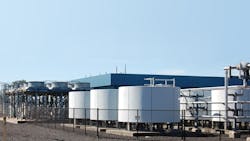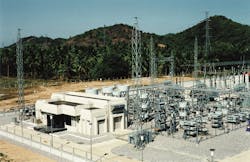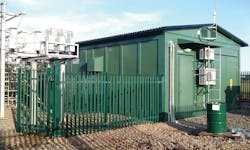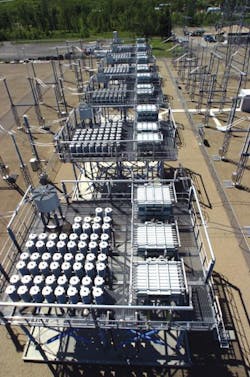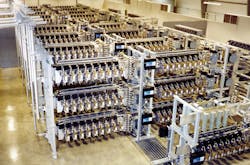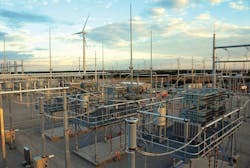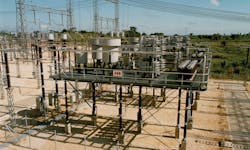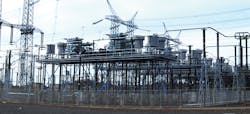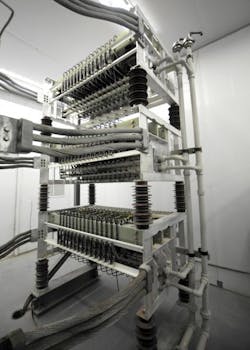Open access and deregulation are having quite an impact on the power-delivery system and the way in which we think about electricity. In fact, electricity is being treated more like a commodity than an engineered product, which is changing the marketplace.
Today there is more volume and volatility but no corresponding increase in transmission and distribution assets. As a result, utilities and transmission operators are scrambling to find ways to increase capacity of existing transmission lines rather than follow the traditional method of placing more wire in the air. Politically, environmentally and financially, there is a great deal of resistance to adding new lines, equating to much longer project time frames and added expense.
Adding more lines is not always the best solution, either. One thing much of the nontechnical world forgets is the simple fact the flow of power follows the laws of physics and not economics, or where they wish the power to go. By the simplest definition, the grid consists of transmission and distribution lines interconnected to form networks for getting electricity to the customer.
There is an interaction between power lines that governs power-transfer limits that can trigger power-system constraints in the form of bottlenecks, congestion and loop flows. These constraints can be significant enough to actually reduce the network’s overall ability to deliver power to the end user.
This continued worldwide increasing demand for electricity is reducing operational margins and can lead to thermal overload, short-circuit limits, transient stability limits, voltage instability and other performance issues. Fortunately, there are several technological developments that have the promise to solve or at least moderate these problems. It is not that utilities have not been using mitigation technologies to diminish these problems, they have, but today’s technologies are far advanced from conventional practices.
Smarter Is Better
Utilities, regional transmission organizations (RTOs) and independent system operators (ISOs) base power-transfer limits on computer simulations that predict how their networks should behave under different system events and loadings. Based on very conservative computer model predictions, these operating authorities reinforce their systems at strategic locations and hope for the best. The modeling does a pretty good job of simulating the spiderweb that is the grid, but, in the final analysis, it is still just a simulation.
The 21st century grid needs real-time assessments to determine what is truly taking place in the dynamic environment of the power grid. RTOs, ISOs and utilities need to know whether the event is a single event or something caused by multi-contingencies everywhere in the power system that will build.
This is where the emerging dynamic technologies come into play. By linking intelligent sensors installed in substations and on the transmission lines to powerful computer programs through high-speed communications arrays, it makes the equipment and lines part of the monitoring schemes. Pulling all of these components together forms a dynamic energy monitoring system with diagnostics and intelligent controls (see T&D World’s “Our Ubiquitous, Dynamic Grid” supplement, December 2013). And it gives the operator a dynamic view of the network from their consoles.
Think of it as an adaptation of several technologies — including dynamic line monitoring, phasor measurement units (PMUs) and energy management systems — combining to form wide-area management systems (WAMS) that have event-driven functionality. Knowing the condition of the grid’s components and how hard it is being stressed is only part of the picture. It is no longer acceptable to drop load or use rolling blackouts.
Wider Area, More Control
As the electric utility industry strives to wring every last watt out of the grid by maximizing the efficiency of the system, the components are being pushed to their physical limits (that is, thermal and stability limits). If they are pushed too far, there can be catastrophic results in the rapid failure of the entire grid. So, not only is it important to see the network’s state in real time, but utilities have to be able to apply countermeasures quickly to avoid exceeding those limits and to keep the power flowing in sufficient quantities to meet the demand.
One proposed scheme getting attention is using control and coordination algorithms to synchronize the operation of multiple flexible ac transmission system (FACTS) controllers installed on a utility’s system. By combining multiple FACTS controllers with some conventional mechanical reinforcement equipment and monitoring the lines, it is possible for WAMS schemes to manage the devices by providing an operational environment that is actually a corrective control system. In effect, these schemes are systemwide dynamic power flow controllers designed to optimize the network in real time.
These arrays are being referred to by several names, but the wide-area control systems (WACS) designation seems to be the most descriptive and fitting. Essentially, the WACS monitors the network’s condition and will use all of the available countermeasures, both FACTS and conventional, to keep the network’s parallel paths playing well with each other.
If the WACS detect some abnormal system condition or event, they will be able to take action quickly to preserve the network’s integrity by operating selected FACTS controllers, conventional reinforcement devices or a combination of them. The result returns the grid to its precondition operation without impacting the power flow.
ABB has done a pilot WACS using one static VAR compensator (SVC) at Statnett in Norway. It uses a power oscillation damping function controlled by wide-area signals from PMUs. The purpose of the pilot is to prove feasibility in real conditions, including possible communication delays and testing security of the approach (that is, that the system successfully switches to a backup local strategy if something happens).
It’s Only Logical
The basic concept for this type of system is that, the majority of the time, the WACS monitors the grid, which normally operates without problems. Of course, losses, congestion and loop flows are always present in one form or another, which is why the WACS concept is gaining traction. Utilities have been installing conventional reinforcements in the form of shunt capacitors and reactors, not to mention more advanced FACTS controllers such as static synchronous compensators (STATCOMs) and SVCs for decades.
Coordinating the interaction between FACTS controllers and these conventional reinforcements has not been attempted to any degree, but it needs to be. By coordinating all of this equipment, it becomes a dynamic corrective control system, providing efficient operation that minimizes losses, reduces congestion and relieves loop flow with the minimum expenditure of funds.
When a disturbance does take place, or congestion increases to the point of impacting power flow, the WACS attention switches more to a mitigation mode. These hybrid systems take advantage of the strengths of FACTS controllers by allowing the cycling and smooth continuous operation to improve system stability and prevent the disturbance from becoming disastrous. Together, the FACTS controllers and conventional equipment work to smooth those power-angle curves utility engineers are so fond of talking about.
Combining Old and New
In its simplest definition, a WACS controls the variables of that curve (that is, the voltage, phase angle and impedance) continuously. Some of the earliest devices developed for these enhancements were the mechanically switched shunt-connected capacitors and reactors. ASEA (now ABB) first introduced the fixed-series capacitors in the early 1950s. Utilities found they could compensate the grid capacitively and inductively to improve the power-transfer capability of the line along with voltage support.
It did not take long for these devices to become an integral part of the bulk transmission system, but, like all advancements, they came with a price. Mechanically switched shunt devices produced transient problems and could not be cycled quickly. Conventional fixed-series capacitors have been known to introduce some power fluctuations and subsynchronous resonance (SSR) oscillations. Fortunately, technology never stands still because engineers are never satisfied; there is always something to add to make a good gadget better.
While this enhancement equipment was being deployed, Siemens developed the monocrystalline silicon semiconductor. GE saw this material had some qualities that could be developed and produced the thyristor, a bipolar semiconductor switching device. This made it possible to build a controllable unidirectional switch, and solid-state power electronics was born.
By 1971, ASEA had applied the thyristor switch to capacitor banks to develop the thyristor-switched capacitor. Several years later, this concept was combined with series capacitors to make the thyristor-controlled series capacitor (TCSC) bank. Siemens made the first utility installation in 1992 when it installed a TCSC in Western Area Power Administration’s 230-kV Kayenta substation in Arizona.
A TCSC has a huge advantage over the existing fixed-series capacitor technology. A TCSC can dampen transient power oscillations caused by disturbances to the system and be used as an effective means of mitigation for SSR, which is attracting more attention of the wind developers as they come to grips with the physics of the electric grid. As penetration of wind generation increases on the transmission grid, utilities are going to be applying such technologies as series compensation to the system to increase capacities and the potential for SSR-like events will increase.
SSR and Wind
A few years ago, the Electric Reliability Council of Texas (ERCOT) reported a SSR problem on a 50% series-compensated transmission system that damaged a couple of wind farms installed on that system. ERCOT called it a subsynchronous control instability (SSCI) event. A fault took place on the transmission line, causing two wind farms to be radially connected to a series-compensated 345-kV line. The system experienced SSCI-induced overvoltages of about 195%, which caused the line to trip.
The ERCOT report goes on to say, “Both wind farms suffered numerous ‘crowbar’ circuit failures. [The crowbar circuit makes the doubly fed induction generator behave the same way as a conventional squirrel cage induction generator to improve fault ride-through abilities.] Fault recorders indicated subsynchronous currents at the series capacitors during the event.”
System simulations show there is a potential for SSR issues for any large wind farms connected to a series-compensated line. The TCSC offers a unique solution for new compensation installation. The TCSC actively dampens transmission line oscillations by matching the exact damping characteristics to the line conditions.
Research and development continued along these lines and now there is a device called a dynamic power flow controller (DPFC). It combines thyristor-switched capacitors and reactors along with mechanical switched shunt capacitors and a phase-shifting transformer. This apparatus is really a hybrid device merging accepted hardware to provide fast controllability with reduced costs compared to a FACTS device like a unified power flow controller (UPFC).
Minding the P’s and Q’s
In the early 1990s, ABB introduced a new technology to the high-voltage direct-current world. It was the voltage source converter (VSC) technology based on the series-connected insulated-gate bipolar transistor (IGBT) valves rather than thyristors, which are controlled with pulse-width modulation (PWM). This technology also was applied to FACTS controllers, which previously had been designed using turn-off devices such as the gate turn-off (GTO) thyristor. The IGBT technology increases the controllability and performance greatly compared to the thyristor.
The STATCOM uses VSC-PWM topology, which allows for superior speed of response but with an inherently symmetrical compensation range, providing improved power quality. The controller connects a capacitor as a shunt element to the grid and is able to provide symmetrical reactive power control (that is, both capacitive and inductive) without introducing harmonics that would have to be filtered out.
An interesting STATCOM variation has been developed using a hybrid STATCOM system with mechanically switched capacitor banks (MSCs) that is more of a static VAR system. MSCs do not operate fast enough to prevent voltage swings dynamically but the STATCOM portion does. The FACTS portion responds quickly, maintaining system voltages at safe levels until the MSCs can catch up, at which point the STATCOM reduces its dynamic response.
If a battery is added parallel to the capacitor, the STATCOM takes a quantum leap forward. This allows the STATCOM battery combination to operate in an almost circular area of the P-Q operational plane, which allows reactive power to be controlled independently of active power. It can then provide more substantial active power capability, but the battery must be controlled throughout the load cycle.
This new adaptation of the STATCOM controller is attractive for wind farms because both the reactive and active power fluctuate in these renewable facilities. With the addition of the battery, the hybrid can store energy and return it as needed, offering options of reinforcement and enhancement to performance, quality and reliability of the grid.
Utilities and transmission operators have tightened their grid interconnection rules to maintain a more stable network with regard to both power flow and voltage support. By adding an energy storage system such as a battery to the STATCOM, the device can either absorb or inject reactive and active power, enabling it to follow the volatile power production of large wind farms.
Solid State of Mind
Once again, the utility’s toolbox is getting new tools to meet the challenges of demand for more energy. There are obvious limits to what can be accomplished with a single tool such as FACTS controllers, dynamic monitoring systems or real-time energy monitoring systems, but as Euclidean geometry points out, the whole is clearly more than the sum of its parts.
By using these tools together, it is possible to improve the overall efficiency of the existing grid while preserving system integrity. The coordination and control of VSC FACTS controllers as part of the dynamic grid adds power-flow controllability to the system. Business drivers are pushing technology, which, in turn, is responding with the flexibility necessary to increase transmission capacity, improve system stability and reduce expensive system losses.
The forces of marketing and finance are demanding optimization for more profitability, but it’s the advances in technologies such as these and the blending of them into sophisticated schemes are making it happen.
About the Author
Gene Wolf
Technical Editor
Gene Wolf has been designing and building substations and other high technology facilities for over 32 years. He received his BSEE from Wichita State University. He received his MSEE from New Mexico State University. He is a registered professional engineer in the states of California and New Mexico. He started his career as a substation engineer for Kansas Gas and Electric, retired as the Principal Engineer of Stations for Public Service Company of New Mexico recently, and founded Lone Wolf Engineering, LLC an engineering consulting company.
Gene is widely recognized as a technical leader in the electric power industry. Gene is a fellow of the IEEE. He is the former Chairman of the IEEE PES T&D Committee. He has held the position of the Chairman of the HVDC & FACTS Subcommittee and membership in many T&D working groups. Gene is also active in renewable energy. He sponsored the formation of the “Integration of Renewable Energy into the Transmission & Distribution Grids” subcommittee and the “Intelligent Grid Transmission and Distribution” subcommittee within the Transmission and Distribution committee.
